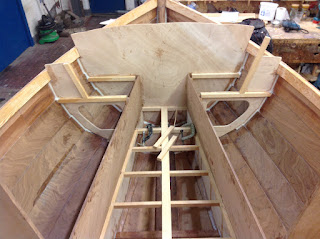19.10.-25.1015
Cockpitconstruction and first deckbeams
 In agreement with Iain Oughtred I increased the cockpit length to get
more space. To do not influence the shape of the hull I left the
original bulkhead as far as possible and added one 300 mm aft for
buoyancy purposes.
In agreement with Iain Oughtred I increased the cockpit length to get
more space. To do not influence the shape of the hull I left the
original bulkhead as far as possible and added one 300 mm aft for
buoyancy purposes.
The cockpit sole, the base for the seats as well as for the back of the seats were glued. I lifted the cockpitsole 70 mm over the plans height to get a better draining effect and keep my feet dry. To compensate the additional height I decreased the height of the seats for 35 mm.

Starting the decking was really an exciting moment. The deckbeams which I already had laminated in evening hours during the first 4 months of the course were notched in and glued into the sheerclamp. The small bulkhead marks the aftposition of the berth.
She´s getting shape!
Sitting and discussing with Steven in the evening hours was always a nice kind of ending the daily work.

























